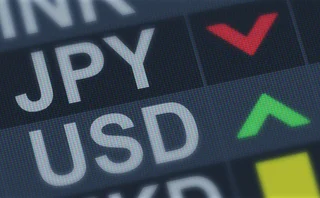
Are market-makers better at dealing with central bank intervention?
Lack of pain following BoJ intervention suggests dealers are better at handling event risk
Not so long ago, news of a central bank intervention could trigger the worst day of the year for a market-maker.
Take the Swiss National Bank’s (SNB) removal of the currency floor in 2015. Most market participants had not anticipated it, and some were exposed. In a matter of 20 minutes, the EUR/CHF exchange rate dropped 30%, from 1.20 to 0.85, as liquidity evaporated and traders scrambled to remove billions of dollars of long EUR/CHF bets. Several banks posted hundreds of millions of dollars in losses.
Now compare that with the most recent interventions by the Bank of Japan into its currency market. As the yen crept above the ¥160 level against the US dollar on April 29, it rebounded sharply to ¥154.5 within minutes, before slipping back to ¥156.5. Reports suggest the BoJ deployed roughly $59 billion to support the yen over the course of the week.
Some credit can be given to the BoJ for telegraphing to the market that an intervention would occur if the yen continued to slide
USD/JPY options vols have doubled over the year at a time where the currency has been an extremely popular choice to fund carry trades. History usually tells us though that when there is volatility, carry trade strategies suffer.
But out of this currency chaos, so far there’s been no reports of pain on the Street.
Some credit can be given to the BoJ for telegraphing to the market that an intervention would occur if the yen continued to slide – even if the market didn’t know exactly when it would happen.
Traders say this uncertainty has put off some hedge funds from making speculative bets, reducing the directional exposures market-makers had to manage. A lack of crowded positions also makes it easier for dealers to maintain a balanced book in the run-up to the intervention.
While intervention risk does make market-making activities more complicated, particularly around key levels in spot FX, dealers say they’ve covered themselves by pricing in higher vol as spot drifts into certain intervention areas.
Furthermore, dealers have become well-accustomed to the new, somewhat funky vol dynamics of the USD/JPY options market.
Typically, when spot rises sharply, the risk reversals – measured by the implied volatility of calls at the 25 delta point minus 25 delta puts – should also increase as demand for calls goes up. But rising USD/JPY spot puts it at risk of intervention, meaning the risk reversals generally fall as spot rises due to increases in vol on puts. Traders say, however, that in practice, when spot reaches the intervention zone it doesn’t always play out like that, and call vol can increase as speculators look for a breakout.
This was shown in the recent intervention at the end of April. On April 26, one-month 25 delta USD/JPY risk reversals sat at -1.67 vols, but rose to -0.86 vols on April 29, the day of the Bank of Japan’s action.
There are two sides to this. On the one hand, this dynamic creates a more challenging market-making environment because of the uncertainty around when intervention is going to happen. But on the other, dealers say there are opportunities for them to take advantage of some mispricing in the vol market.
So, has this episode suggested market-makers are now better at handling G10 central bank interventions? The answer is mixed.
While senior traders at the banks have learnt lessons from previous events, you could argue the BoJ’s move lacked bite and its intervention hasn’t really put market-makers through a real test.
The return of the speculative hedge fund community could change this, with one dealer saying they’re looking to add shorter-term barrier options to express topside USD/JPY views, with tighter take-profit levels.
In an extreme change to the trends that dominated FX trading last year, the yen options market will keep G10 trading one of the more interesting markets to monitor.
Editing by Lukas Becker
Only users who have a paid subscription or are part of a corporate subscription are able to print or copy content.
To access these options, along with all other subscription benefits, please contact info@fx-markets.com or view our subscription options here: https://subscriptions.fx-markets.com
You are currently unable to print this content. Please contact info@fx-markets.com to find out more.
You are currently unable to copy this content. Please contact info@fx-markets.com to find out more.
Copyright Infopro Digital Limited. All rights reserved.
As outlined in our terms and conditions, https://www.infopro-digital.com/terms-and-conditions/subscriptions/ (point 2.4), printing is limited to a single copy.
If you would like to purchase additional rights please email info@fx-markets.com
Copyright Infopro Digital Limited. All rights reserved.
You may share this content using our article tools. As outlined in our terms and conditions, https://www.infopro-digital.com/terms-and-conditions/subscriptions/ (clause 2.4), an Authorised User may only make one copy of the materials for their own personal use. You must also comply with the restrictions in clause 2.5.
If you would like to purchase additional rights please email info@fx-markets.com
More on Trading
Do BIS volumes soar past the trend?
FX market ADV has surged to $9.6 trillion in the latest triennial survey, but are these figures representative?
Hedge funds switch yen bets after Japan election shock
Takaichi victory forces unwinds and a move to topside trades, while barriers give dealers a headache
BIS 2025 FX survey: What the results mean for global markets
Key findings from the BIS triennial FX and OTC derivatives survey
Hedge funds keep a toe in HKD carry trade despite rate rise
Positioning is currently a fifth of what it was in April, say dealers
Wells Fargo hires e-FX trading head for Europe
US bank also makes several senior changes to its European FX and rates trading business
Morgan Stanley sees the elephants in the room
Fixed income co-head Jakob Horder argues hedge fund crowding means macro markets have fatter tails; eyes more FX hedging to come
Natixis bolsters Apac market-making presence with new hires
Additions include head of Apac linear G10 rates and FX trading, and China markets head
Low-vol gold rush points to further upside
Options markets see no scramble to chase metal higher despite 43% year-to-date rally








